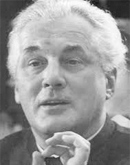

Sep Ruf
*9. 3. 1908 – Munich, Germany
†9. 7. 1982 – Munich, Germany
Biography
1926-31 - studies at the Technical University of Munich1931-32 - collaboration with the architectural firm Lechner & Norkauer
1932 - founded his own architecture practice in Munich
1947-53 - professor at the Academy of Fine Arts in Nuremberg
1953-72 - professor at the Academy of Fine Arts in Munich
since 1971 - office with four other partners
Sep Ruf, born Franz Joseph Ruf, is one of the most significant modernist architects in Germany. His airy buildings influenced the entire post-war architecture in Germany and served as examples of internationally oriented architecture in the country.
Sep Ruf began studying at the Technical University of Munich after his internship at the Imperial Railway Workshops in Oberpfaffenhofen, where he graduated in 1931 under German Bestelmeyer and became a freelance architect. He maintained contact with Walter Gropius, Ludwig Mies van der Rohe, and Ludwig Grote, interpreting the ideas of Bauhaus in a somewhat different way. From 1947 to 1953, he was a professor at the Academy of Fine Arts in Nuremberg, which at that time was located in the German Monastic Castle in Ellingen due to the war-damaged city. From 1953 to 1972, he taught architecture and urban planning at the Academy of Fine Arts in Munich, serving as chairman of the board from 1958 to 1961 and being appointed an honorary member in 1971.
Ruf designed public buildings as well as private houses inspired by Bauhaus throughout Germany. Above all, however, he shaped a new image of Munich and Nuremberg after World War II. He developed his own style characterized by minimalist construction, transparent walls, and thin roofs. The lightness of his buildings contrasted sharply with traditional Bavarian architecture.
The English translation is powered by AI tool. Switch to Czech to view the original text source.
Realizations and projects
Other buildings
German Pavilion at the World Expo in Brussels, 1958Olaf Gulbransson Museum, Tegernsee, 1964-66
Office Bungalow, Bonn, 1963-66
American Consulate General, Munich, 1957-59










